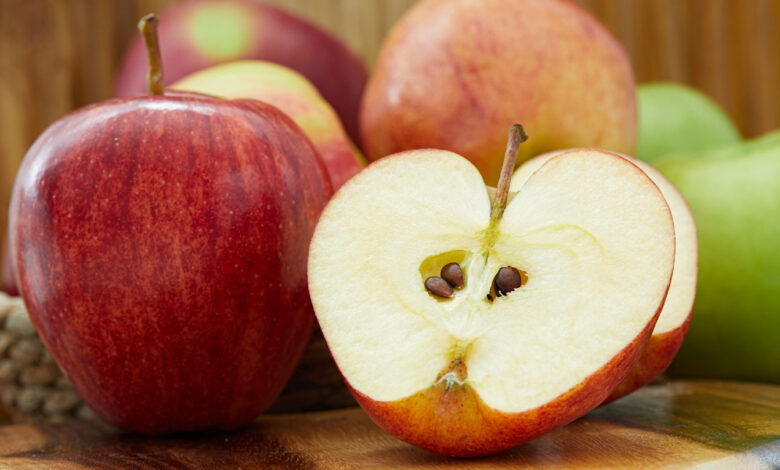How to keep fruit slices fresh


acidic: An adjective for materials that contain acid. Acidic materials often are capable of dissolving away some minerals such as carbonate, or preventing their formation in the first place.
Arctic: A region that falls within the Arctic Circle. The edge of that circle is defined as the northernmost point at which the sun is visible on the northern winter solstice and the southernmost point at which the midnight sun can be seen on the northern summer solstice. The high Arctic is that most northerly third of this region. It’s a region dominated by snow cover much of the year.
average: (in science) A term for the arithmetic mean, which is the sum of a group of numbers that is then divided by the size of the group.
axis: (in mathematics) The line to the side or bottom of a graph. It is labeled to explain the graph’s meaning and the units of measurement.
cell: (in biology) The smallest structural and functional unit of an organism. Typically too small to see with the unaided eye, it consists of a watery fluid surrounded by a membrane or wall. Depending on their size, animals are made of anywhere from thousands to trillions of cells. Most organisms, such as yeasts, molds, bacteria and some algae, are composed of only one cell.
chemical: A substance formed from two or more atoms that unite (bond) in a fixed proportion and structure. For example, water is a chemical made when two hydrogen atoms bond to one oxygen atom. Its chemical formula is H2O. Chemical also can be an adjective to describe properties of materials that are the result of various reactions between different compounds.
compost: The end product in the breakdown, or decomposition, of leaves, plants, vegetables, manure and other once-living material. Compost is used to enrich garden soil, and earthworms sometimes aid this process.
compound: (often used as a synonym for chemical) A compound is a substance formed when two or more chemical elements unite (bond) in fixed proportions. For example, water is a compound made of two hydrogen atoms bonded to one oxygen atom. Its chemical symbol is H2O.
control: (n.) A part of an experiment where there is no change from normal conditions. The control is essential to scientific experiments. It shows that any new effect is likely due only to the part of the test that a researcher has altered. For example, if scientists were testing different types of fertilizer in a garden, they would want one section of it to remain unfertilized, as the control. Its area would show how plants in this garden grow under normal conditions. And that gives scientists something against which they can compare their experimental data. (v.) To include some unchanged or unaffected conditions in an experiment so their results could later be contrasted with those from where changes had been made.
development: (in biology) The growth of an organism from conception through adulthood, often undergoing changes in chemistry, size and sometimes even shape.
edible: Something that can be eaten safely.
environment: The sum of all of the things that exist around some organism or the process and the condition those things create. Environment may refer to the weather and ecosystem in which some animal lives, or, perhaps, the temperature and humidity (or even the placement of things in the vicinity of an item of interest).
enzymes: Molecules made by living things to speed up chemical reactions.
fruit: A seed-containing reproductive organ in a plant.
function: The specific role some structure or device plays.
horizontal: A line or plane that runs left to right, much as the horizon appears to do when gazing into the distance.
inhibit: To slow or prevent something from happening. To provide some resistance to a movement or action.
liquid: A material that flows freely but keeps a constant volume, like water or oil.
marker: (in biomedicine) The presence of some substance — such as the attachment of some stain or molecular flag — that usually signals some disease, pollutant or event. As such, this substance will serve as a sign — or marker — of that related thing.
mechanical: Having to do with the devices that move, including tools, engines and other machines (even, potentially, living machines); or something caused by the physical movement of another thing.
melanin: A family of pigments found in all types of animals. They are responsible for the dark coloring in such things as feathers, hair, fur, skin and scales.
oxidation: (adj. oxidative) A process that involves one molecule’s theft of an electron from another. The victim of that reaction is said to have been “oxidized,” and the oxidizing agent (the thief) is “reduced.” The oxidized molecule makes itself whole again by robbing an electron from another molecule. Oxidation reactions with molecules in living cells are so violent that they can cause cell death. Oxidation often involves oxygen atoms — but not always.
oxygen: A gas that makes up about 21 percent of Earth’s atmosphere. All animals and many microorganisms need oxygen to fuel their growth (and metabolism).
pigment: A material, like the natural colorings in skin, that alter the light reflected off of an object or transmitted through it. The overall color of a pigment typically depends on which wavelengths of visible light it absorbs and which ones it reflects. For example, a red pigment tends to reflect red wavelengths of light very well and typically absorbs other colors. Pigment also is the term for chemicals that manufacturers use to tint paint.
ranking: An ordering of things or individuals based on some scale or agree-upon values; a hierarchy.
salt: A compound made by combining an acid with a base (in a reaction that also creates water). The ocean contains many different salts — collectively called “sea salt.” Common table salt is a made of sodium and chlorine.
statistics: The practice or science of collecting and analyzing numerical data in large quantities and interpreting their meaning. Much of this work involves reducing errors that might be attributable to random variation. A professional who works in this field is called a statistician.
taste: One of the basic properties the body uses to sense its environment, especially foods, using receptors (taste buds) on the tongue (and some other organs).
vertical: A term for the direction of a line or plane that runs up and down, as the vertical post for a streetlight does. It’s the opposite of horizontal, which would run parallel to the ground.



